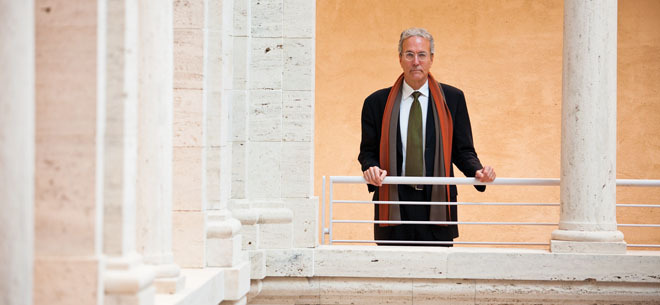Rebuilding Project

Thomas Lentz, the Elizabeth and John Moors Cabot Director of the Harvard Art Museums, has been at the helm of the university museum’s latest major expansion since plans began in 2008. Six years later, he is finally ready to see his efforts come to fruition.
“This project was much more than a building project,” Lentz says. “We took everything apart here—physically, structurally, operationally, conceptually—and put it back together again with a different operating model.” Lentz commissioned the addition, designed by architect Renzo Piano, to connect all the Harvard Art Museums—the Fogg, Busch-Reisinger and Arthur M. Sackler museums.
“This museum has always been built on certain core principles,” Lentz explains, “and one them is the power and value of close, sustained looking and thinking about works of art. We wanted there to be plenty of room to breathe, not just for the works of art, but also for the people interacting with works of art.”
The Calderwood Courtyard—a glass-enclosed, naturally lit space reminiscent of an Italian piazza—acts as the hub of the facility, and the Art Study Center—where students, faculty and members of the public can request a work of art to study—offers a different kind of viewing experience. Visitors are encouraged to plan ahead and schedule an appointment for close examination of works not always on display.
“We have one of the biggest and best collections in the country,” Lentz says proudly. The Harvard Art Museums recently received the Feinberg Collection, a major gift of important Japanese art, and selections will be on display along with the museums’ early Chinese Buddhist sculpture, ancient Chinese jade and German Expressionist and Bauhaus works. With the new addition, a fresh emphasis will be placed on modern and contemporary art, yet the vast majority of the collection remains historical in nature.
What does Lentz see as the museum’s greatest strength? “You just asked me an impossible question,” he says. “My long ago field is Islamic art, and some of the Persian paintings on display will always have a great resonance with me.” He is also partial to a working collection of Bernini’s clay models, which experts know were sculpted in a natural-light setting. They’re fittingly on display in a light-filled gallery and Lentz sees them as a “revelation” for visitors.
Lentz’s wish for the re-opening? “We hope when people walk in, they’ll recognize [the Harvard Art Museums] as the old museum, but see that it’s different and better.”


